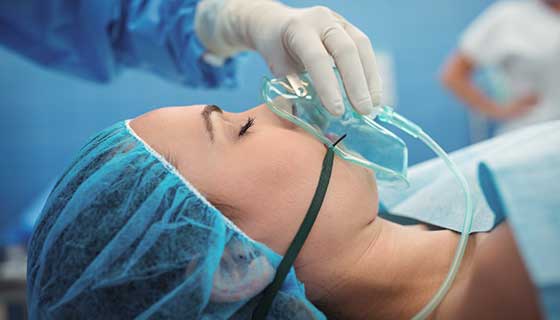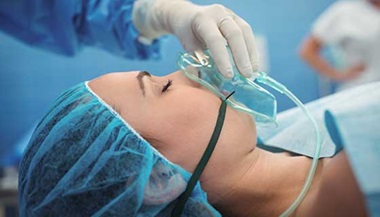Procedural Sedation
What is procedural sedation?
Procedural sedation is a medical technique. It’s used to calm a person before a procedure. It involves giving you sedatives or pain pills. These drugs ease discomfort, pain, and anxiety. They are usually given through an IV line in your arm. Or you may swallow or inhale them.
While you are under this type of sedation, you will have your procedure. Your medical team will carefully observe your heart and breathing. You will likely be awake the whole time. But you may not remember anything afterward.
The level of sedation can vary. It can range from minimal to fairly deep. People who need only a little can respond normally to questions and requests. If you are put under a deeper level of sedation, you may need some stimulation to respond. You are not put into deep sleep. That’s called general anesthesia.
Why might I need procedural sedation?
The technique is used for a lot of procedures. The goal is to reduce pain, anxiety, and unpleasant memories of a procedure. It can also make a procedure more effective. For instance, feeling relaxed may make it easier to fix a broken bone.
Procedural sedation is used only for short, straightforward procedures. It is not used for complex surgeries. Some procedures that use this type of sedation include:
- Bone or joint realignment to fix a broken bone or dislocated joint
- Breast biopsy to evaluate a lump in the breast
- Bronchoscopy to evaluate lung conditions
- Dental surgery
- Electrical cardioversion to restore a normal heart rhythm
- Endoscopy for gastrointestinal problems
- Lumbar puncture to check for neurological disease
- Minor foot or skin surgery
What are the risks for procedural sedation?
Procedural sedation is a fairly safe practice. Your own risks may differ somewhat. They are based on your age and any other medical conditions you may have. They also depend on the type of sedation you are given.
Some possible side effects are:
- Changes in heart rate and blood pressure (rare)
- Decreased rate of breathing
- Headache
- Inhalation of stomach contents into your lungs (rare)
- Nausea and vomiting
- Unpleasant memory of the experience
Side effects are usually not serious. They tend to go away shortly after the procedure. Your medical team can also prevent many of them by watching you closely during your procedure.
How do I prepare for procedural sedation?
You will be told how to prepare for your procedure. Beforehand, let your healthcare provider know about the following:
- Your medical history
- Any past problems with sedation or anesthesia
- Any recent symptoms, such as a sudden fever
- Any medicine you are taking, including over-the-counter drugs, such as aspirin
If needed, you should stop smoking before your procedure. That will help lower your chance of problems. You should also not eat or drink anything after midnight before your scheduled procedure. Sometimes sedation is still used in the case of an emergency even if a person has eaten recently. You’ll also need to arrange to have someone available to drive you home afterward.
In some cases, you may need other tests to check your health before your procedure. These might include:
- Basic blood work to check for anemia and infection
- Chest X-ray to view your heart and lungs
- ECG or EKG to check your heart rhythm
What happens during procedural sedation?
Ask your healthcare provider about what to expect when you are sedated. Only those who are specially trained in the technique will perform it. You might have the procedure in a hospital or an outpatient surgery facility.
In general, you can expect the following:
- You will be given medicine through an IV line (often through a vein in your arm). Or you may receive a shot. The medicine may also be given by mouth or by inhalation.
- If you receive medicine through an IV, you may feel the effects very quickly.
- You should start to feel relaxed and drowsy.
- Your breathing and blood pressure may drop a little. But you shouldn’t need help with your breathing. You might receive a little extra oxygen through a mask.
- Throughout the procedure, your heart rate, your breathing, and your blood pressure will be closely watched.
- You will probably stay awake the entire time. If you do fall asleep, you should be easy to wake, if needed. You should feel little or no pain.
- When your procedure is over, the medicine will be stopped. You should return to normal consciousness fairly quickly.
What happens after procedural sedation?
You may have a dim memory of the procedure. Or you may not remember it at all. You will likely be drowsy for a while afterward. You will be closely watched as you return to full consciousness.
You should be able to return home within an hour or two after your procedure. Plan to have someone stay with you for at least a few hours. Depending on the reason for your sedation, you may receive more directions. For example, you may need to keep the area of a surgical incision elevated.
Side effects like headache and nausea often go away quickly. But tell your healthcare provider if they persist. Depending on the type of procedure you had, you may need to take pain medicine.
You can usually go back to a normal diet and most of your regular activities soon after the procedure. But don’t drive or make any important decisions for at least 24 hours. Be sure to follow all after-care instructions. Also take any medicine as directed. Depending on your procedure, you may need more treatments or follow-up procedures.
Next steps
Before you agree to the test or the procedure make sure you know:
- The name of the test or procedure
- The reason you are having the test or procedure
- What results to expect and what they mean
- The risks and benefits of the test or procedure
- What the possible side effects or complications are
- When and where you are to have the test or procedure
- Who will do the test or procedure and what that person’s qualifications are
- What would happen if you did not have the test or procedure
- Any alternative tests or procedures to think about
- When and how will you get the results
- Who to call after the test or procedure if you have questions or problems
- How much will you have to pay for the test or procedure



